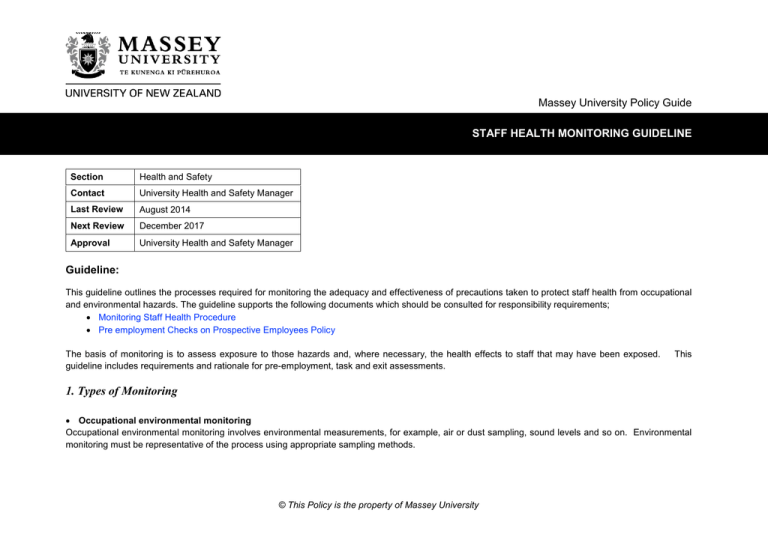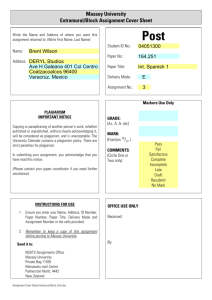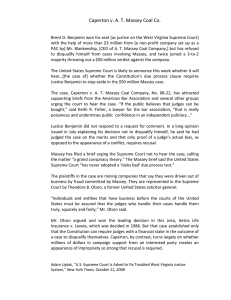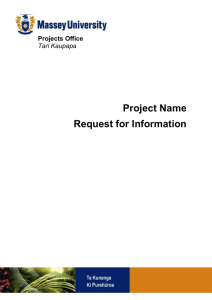Staff Health Monitoring Guideline
advertisement

Massey University Policy Guide STAFF HEALTH MONITORING GUIDELINE Section Health and Safety Contact University Health and Safety Manager Last Review August 2014 Next Review December 2017 Approval University Health and Safety Manager Guideline: This guideline outlines the processes required for monitoring the adequacy and effectiveness of precautions taken to protect staff health from occupational and environmental hazards. The guideline supports the following documents which should be consulted for responsibility requirements; • Monitoring Staff Health Procedure • Pre employment Checks on Prospective Employees Policy The basis of monitoring is to assess exposure to those hazards and, where necessary, the health effects to staff that may have been exposed. guideline includes requirements and rationale for pre-employment, task and exit assessments. This 1. Types of Monitoring • Occupational environmental monitoring Occupational environmental monitoring involves environmental measurements, for example, air or dust sampling, sound levels and so on. Environmental monitoring must be representative of the process using appropriate sampling methods. © This Policy is the property of Massey University Massey University Policy Guide Staff Health Monitoring Guideline – Page 2 • Health monitoring Health monitoring involves direct monitoring of an individual’s health indicators such as blood, urine or lung function tests, audiometric tests and so on. Health monitoring is required where there is an identifiable disease or health effect that is related to the occupational exposure. There must be valid techniques for detecting the indicators of the effect of the hazard on the individual’s health. The process and type of health monitoring in teaching and research are detailed in the table below which is based on Australasian University practice and the Department of Labour publication “Guidelines for Workplace Health Surveillance” (available at http://www.osh.dol.govt.nz/). 2. Health Monitoring Assessment and Process The purpose of health monitoring is to determine if the precautions taken to protect staff from occupational hazards are adequate and effective. Health Monitoring Assessment Procedure 1. Supervisors and/or Managers are to ensure that all identified hazards are placed in the Department/ College Hazard Register and are fully assessed and controlled through the hierarchy of controls. This is essential as health monitoring requirements are dependent on hazard control methods. 2. Where control for a significant hazard is to minimise exposure and personal protective equipment use is required, Supervisors/ Managers are to ensure health monitoring if practicable is undertaken. The assessments recommended below are only invoked if the hazard cannot be eliminated, (1) isolated, or minimised to a safe level. (2) 3. Despite the mandatory requirement, health monitoring can only be used in the following situations : There must be an identifiable disease or health effect related to the exposure There is evidence a health risk exists Health surveillance techniques are available 4. The information details the recommended types of health monitoring (as applicable, and once permission is obtained by the staff member in question) is to be arranged and continued as detailed in the table below. Campus Health and Safety Advisors can provide specialist services to (3) assist with monitoring . © This Policy is the property of Massey University Massey University Policy Guide Staff Health Monitoring Guideline – Page 3 5. If the requirements detailed in point 3 above cannot be met, a general Health & Hazard Assessment Questionnaire can be used by staff working in areas and in positions where hazards may impact health in a non-determinable way. Notes (1) Safe in this context means not likely to cause Serious Harm. Serious harm has a specific legal definition. (2) Based on Department of Labour Guidelines, 1997, Management of substances hazardous to health, An introduction to the guidelines for workplace surveillance. (3) The Centre for Ergonomics, Occupational Safety and Health; and Public Health Research, also have relevant services and information. 3. Health Monitoring Process Where a task or a position exposes a staff member to a significant hazard that affects their health, and where minimisation and personal protective equipment is used as the control method, then arrangement must be made for monitoring. Monitoring needs to be undertaken prior to, during and at completion of the exposure period. Such monitoring may be throughout the term of employment or may be limited to a particular task or research activity undertaken by the exposed staff member. Hazard Staff at High Risk (is not limited to the examples given) Initial Checks/ Assessment Monitoring Required Manual handling & Ergonomics: Supervisors/ Managers to organize manual handling training and workplace assessment through the Health & Safety Office. Manual handling and repetitive work. Past history of back/joint injury Childcare workers Veterinarians Nurses Custodians Gardeners Printery staff Extramural dispatch Workshop staff Check past injury or problems. Check musculoskeletal status. Ensure correct equipment is available in Department for assistance with lifting/ manual handling Provide information on correct manual handling techniques. Ensure training and awareness of correct lifting techniques. © This Policy is the property of Massey University Manual handling risk assessment Review on individual basis when discomfort is reported. Massey University Policy Guide Staff Health Monitoring Guideline – Page 4 Work station; repetitive and extended periods in a restricted position. Word processing, data entry & extended periods working with computers. Past history of over use or upper limb injury. Employees who work on computer keyboards for extended periods Contact University Rehabilitation and ACC Administrator to arrange occupational capacity assessment if high risk. Refer to the following website guidance: http://www.habit@work.co.nz Professional advice or assessment on workplace and job design Review on individual basis when musculoskeletal discomfort reported, provide workplace assessment. Noise & Respiratory Hazards: Supervisors/ Managers to ensure staff obtain hearing and lung function testing within 3 months of commencement provided pre-existing condition does not restrict ability to undertake proposed duties. Testing can be arranged through Campus Health & Safety Advisors. High noise levels requiring hearing protection. Previous exposure to high noise. Existing hearing loss. Ongoing exposure to high noise. Musicians Farm staff Staff using hand held noisy petrol power tools Ensure training and awareness of safety procedures Baseline Audiometry within 3 months of commencing employment. Check previous noise exposure history and audiograms. Audiometry every 2 years, more frequently if previous hearing loss is indicated. Exit monitoring to be conducted in employee’s final month of employment Operations producing dust including lung irritants, animal dander, welding; glass blowing, epoxy resins. History of Asthma or other respiratory disorders. Ongoing exposure to lung irritating products. Staff with exposure to contaminants in the air, isocyanates, dust, silica and so on Laboratory and intensive animal handlers Staff using welders Glass blowing Design studios Ensure training and awareness of safety procedures Baseline Lung Function Testing (spirometry) within 3 months of commencing employment. Check previous exposure history and spirometry records. Spirometry every year, more frequently if previous respiratory disorders are indicated as present. Skin macular symptoms if heavy metal exposure Exit monitoring to be conducted in employee’s final month of employment. Hazardous Substances: Supervisors/ Managers to ensure staff have appropriate training and screening where applicable within 3 months of commencement. The following guidelines pertain to work situations where specific causative materials are predominately used. The WES should be consulted for what substances have biological monitoring indices Heavy Metals, (e.g. aluminium, chromium, lead, manganese, mercury, Past history of illness (affecting the liver, kidneys, any malignancy or immune deficiency disorders, including leukaemia). Heavy past exposure Base line test and period. Other tests as required by Hazardous Chemical protocols, (this may include pathologies and spirometry). © This Policy is the property of Massey University Biological monitoring as detailed in WES Massey University Policy Guide Staff Health Monitoring Guideline – Page 5 Carcinogens Any past occupational exposure to carcinogenic substances Ensure past occupational exposure is documented, and pre employment checks*, training and awareness of safety procedures. * Other tests as required (this may include pathologies, spirometry and x-rays). Confirmed histology and causative as per ACC schedule 2 Organic material with long half life identifiable metabolites e.g., n-Hexane, Methanol, MEK, PCP, Styrene, organo phosphates, trichochoro ethylene Heavy past exposure. Pesticide users Histopathology lab staff Staff using degreasers, printery solvents Pathology testing as indicated by nature of substance and biological indices Biological monitoring as detailed in WES. Testing as indicated by nature of substance and level of exposure Carbon monoxide Users of internal combustion engines, gas or fuel burners in enclosed spaces Not applicable Biological monitoring as detailed in WES Skin or eye hazardous substances Laboratory staff, cleaners, studio staff, health workers Ensure past allergenic or dermatitis problems documented Self reporting by staff Microbial/Biological: Supervisors/ Managers to ensure staff arrange for appropriate vaccination (where available) within 3 months of commencement. Recombinant DNA. Past history of malignancy and Immunosuppressed individuals. PC 3 and above to seek medical opinion. As indicated by PC level. Screening as required for exposures/risks identified Infectious micro-organisms Laboratory staff working with Risk Group 2 and above microorganisms and/or samples which may contain Risk Group 2 or above microorganisms (e.g. human or animal faecal or blood samples) Childcare workers. Catering: Food preparation Food labs, food pilot plant staff Health staff/Nurses Female and pregnant/trying for pregnancy. Staff/students travelling to higher risk countries Previous vaccinations For individual assessment relating to exposures/risks and previous vaccinations. Check immunisation history and upgrade as necessary. Check history of Hepatitis, skin complaints or recent overseas travel SOS travel advisories and vaccination/precautionary requirements Immunisation may be required for: Hep A and B, Tetanus, Measles, Mumps, Rubella, Varicella (Chicken Pox), Pertussis (Whooping cough), Meningococcal Meningitis, and Polio. Suggested annual Influenza vaccination. Vaccination against zoonotic organisms -where available Screening as required for exposures/risks identified. May require annual screening. © This Policy is the property of Massey University Ensure immunisation kept up-todate Massey University Policy Guide Staff Health Monitoring Guideline – Page 6 Use or care of animals; (rats, mice, rabbits, guinea pigs, cats, bats, fowl/birds, primates, native fauna, cattle, sheep, goats and other furry animals). History of asthma, hay fever, eczema and allergies. Laboratory and intensive animal handlers Veterinarians Spirometry, RAST (radioallergosorbent blood test) may be required for identification of allergy susceptibility. Visiting an abattoir or working with samples from an abattoir. Past exposure. Immunisation for specified animals (cattle, sheep, goats). Vaccination against zoonotic organisms (where available). Working with unfixed human blood or tissue. Persons working with unfixed human tissue, First Aiders and persons involved with injury treatment. Researchers taking or working with human samples Check Hep B Status. Immunise if required. May require Hep A (if working with GI tissue and faecal matter). Hep B titre, (HIV and Hep C screen if requested but not compulsory). Hep B booster if required. Exposure to sewerage or rubbish collection. Plumbers Check Hep A Serology. Check Tetanus status. Booster(s) if required. Tetanus vaccination reviewed at time of commencement, booster required at 10 years, or if Tetanus prone injury occurs. Ensure appropriate training and awareness of safety procedures Check immunisation history and upgrade as necessary. Seek advice from Health & Safety Advisors regarding any hazards not mentioned above. Ensure immunisation kept up-todate. Incidental work requiring any of the above. Spirometry testing. Radiation: For Radiation Safety Information refer to: http://hrs.massey.ac.nz/massey/staffroom/national-shared-services/health-safety/managing-hazards/radiation.cfm Ionizing Radiation: History of malignancy or immune deficient diseases. Pilots X-ray Some lab workers Ensure training and awareness with safety procedures Self monitoring within department. UV Radiation i.e. Exposure to sun. History of Melanomas. Check for history of Melanomas Yearly skin monitoring for changes © This Policy is the property of Massey University Massey University Policy Guide Staff Health Monitoring Guideline – Page 7 Gardeners/ staff who work outdoors Field workers Ensure appropriate clothing, eyewear and hat. Ensure frequent application of sunscreen Encourage skin check (mole mapping) programme with own doctor to moles and lesions. Other Risks Other hazardous equipment being used. Other potential hazards not mentioned above. Associated with Overseas Travel. 4. Seek advice from Campus Health & Safety Advisors regarding any hazards not mentioned above Past history of Malaria, Dengue Fever, Yellow Fever Check basic immunisations for all destinations, Polio, MMR, Hep A & B, and Tetanus should be considered. Other immunisations and anti-malarials should be discussed with personal doctor at least 6 weeks prior to departure. Ensure immunisations and antibiotics are kept up-to-date. This must be done on an individual basis. Recommendations change regularly, refer to SOS travel advisories for up to date advice. Funding of monitoring costs The extent of staff monitoring is dependent on the activities within a particular work area, environment or professional discipline and the methods used by managers to control hazards. Where low-level and last-resort controls such as personal protective equipment or clothing are used, then monitoring costs will be higher. Where more sophisticated controls such as isolation or elimination of hazards are used, staff monitoring costs will be less. However, some hazards cannot be eliminated or isolated, and so monitoring in those situations becomes inevitable. Funding arrangements are as follows: • The cost of routine environmental and medical health monitoring is to be factored into departmental/unit budgets as a part of their operations. Initial determinations of the need for environmental monitoring may be funded from the Health and Safety office or from regional budgets. Campus Health and Safety Advisors can assist with initial determinations of monitoring and advise on appropriate methods for where there is an ongoing requirement. © This Policy is the property of Massey University Massey University Policy Guide Staff Health Monitoring Guideline – Page 8 • 5. Monitoring of vision with visual display use, and discomfort, pain and injury workplace assessments, which are common to all University activity, is funded centrally by the Health and Safety office. Pre–employment monitoring (informative) The Pre-employment Checks on Prospective Employees Policy contains responsibility for pre employment monitoring. The rationale for the pre employment questions are detailed below. The University uses a self disclosure question in its Employment Application form to determine the above matters, i.e. “Have you had an injury or medical condition caused by gradual process, disease or infection – for example hearing loss, sensitivity to chemicals, repetitive strain injury – which the task of this job may aggravate or contribute to?” In addition there are specific physical, visual, and working condition requirements within any position. As these requirements vary considerably within any position, the University relies on the applicant to self disclose any mismatch between these requirements and their individual capacity. The Employment Application forms ask – “Have you any condition which may affect your ability to carry out effectively and safely the functions and responsibilities of this position?” The onus, therefore, is on the job applicant to be open and honest in disclosing any condition that may prevent them from carrying out any aspect of the position – as stated in the Job Description, or to the specifications outlined in the Person Specification. The appointment panel must be vigilant in assessing all applications and questioning any areas where an acknowledged condition may be problematic, and to arrange baseline testing to establish certainty. However if a hazard is still significant after minimisation and personal protective equipment is used as the control method, then baseline health monitoring (i.e. the health status at time of engagement) is strongly recommended. © This Policy is the property of Massey University Massey University Policy Guide Staff Health Monitoring Guideline – Page 9 6. Recording of monitoring results Monitoring results: Managers are to ensure that the results of environmental monitoring are presented to affected staff and any other staff who ask for them. The data must be interpreted by a suitably qualified person who has an understanding of the hazards as well as occupational safety and health implications or potential. Results shall not identify individual staff. The results are to be held within the Department and copied to the Campus Health and Safety Advisor. Results of health monitoring are to be made available to the individual staff member, and interpreted by a suitably qualified person who has an understanding of the hazards as well as occupational safety and health implications or potential. Under no circumstances are results of one employee to be given to other employees. The results are to be held on a personnel file either in Human Resources or Organisational units, and copied to the University Accident Register held at the Health and Safety Office. Unit held monitoring results are to be submitted to Human Resources at the cessation of the monitoring period or employment. Sub-optimal results: If monitoring results show that an employee’s health is affected by the hazard(s), then the following is to occur: • Substandard results are entered in accident register and investigated. Hazard controls are reviewed as part of an accident investigation. Campus Health and Safety Advisors, the affected employee(s) and manager should be involved in the review process. The purpose of the review is to identify causes of the sub-optimal results and make recommendations to reduce exposure. Referral to the ACC and Rehabilitation Administrator (to ensure that medical and vocational needs are addressed. Notification to Department of Labour if significant harm has occurred. Audience: Staff managers. © This Policy is the property of Massey University Massey University Policy Guide Staff Health Monitoring Guideline – Page 10 The term “manager” covers any staff member with authority to supervise other staff, visitors, and persons with business at Massey University. Manager includes titles such as; Vice Chancellor, Registrar, Pro Vice Chancellor, Assistant Vice Chancellor, Head of Department, Head of School, Head of Institute, Head of College, Head of Section, Director, Manager, team leader and equivalent titles. Related procedures / documents: Policy on Pre-employment Checks for Prospective Appointees. Employment agreements Document Management Control: Prepared by: University Health and Safety Manager Owned by: Assistant Vice Chancellor – People and Organisational Development Authorised by: University Health and Safety Manager Approved by: SLT 16 April 2012 Last review: August 2014 Next review: December 2017 © This Policy is the property of Massey University




